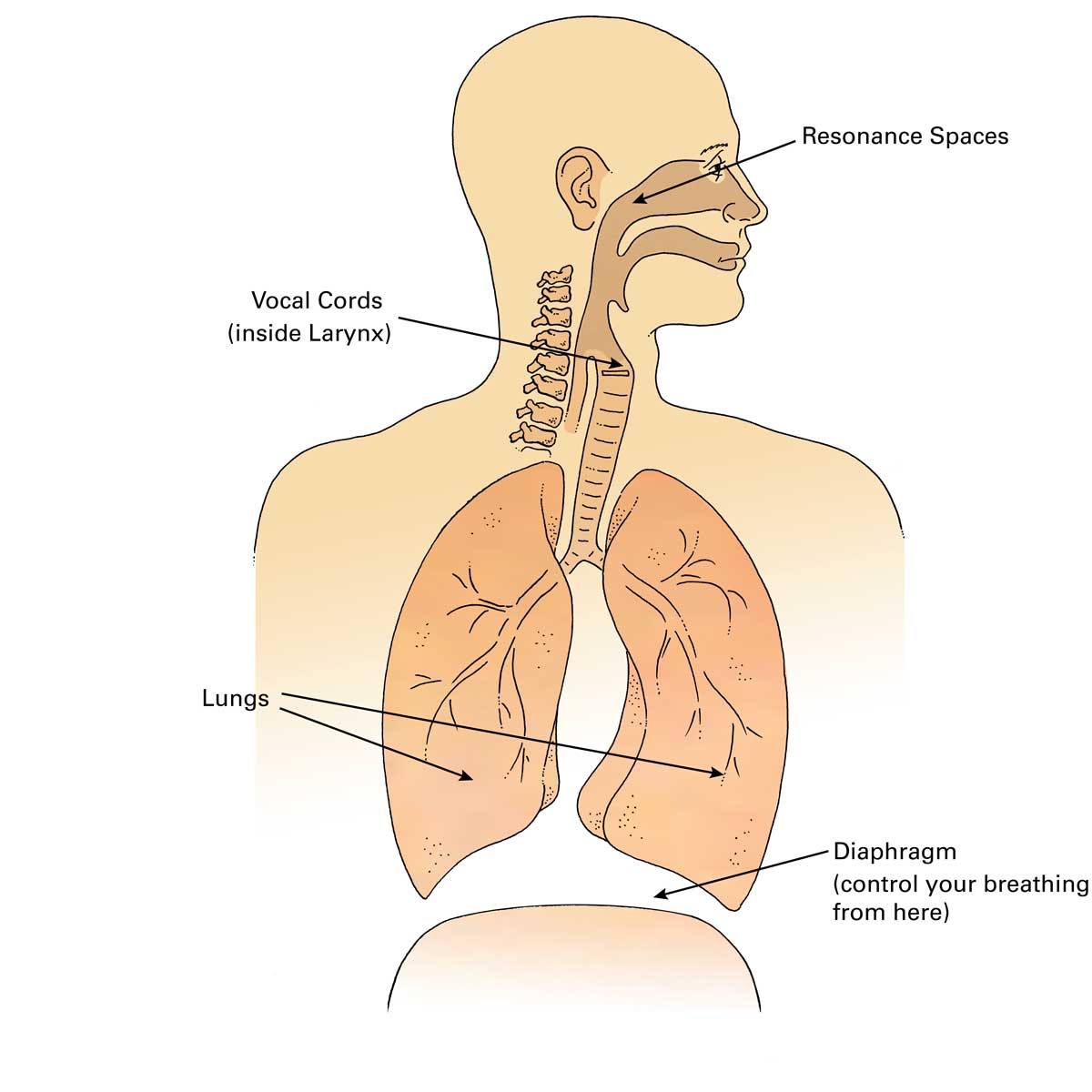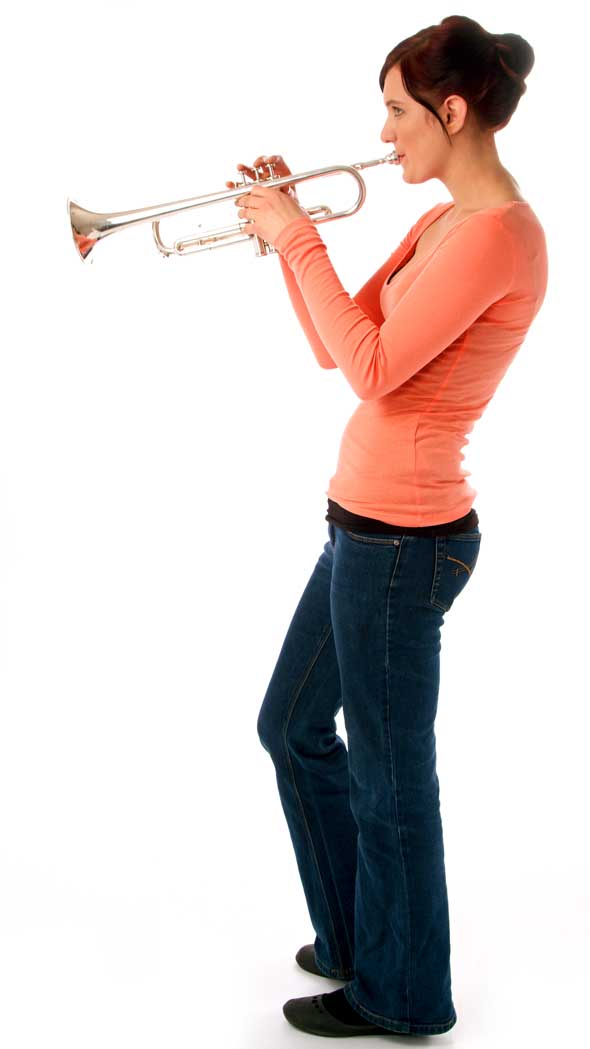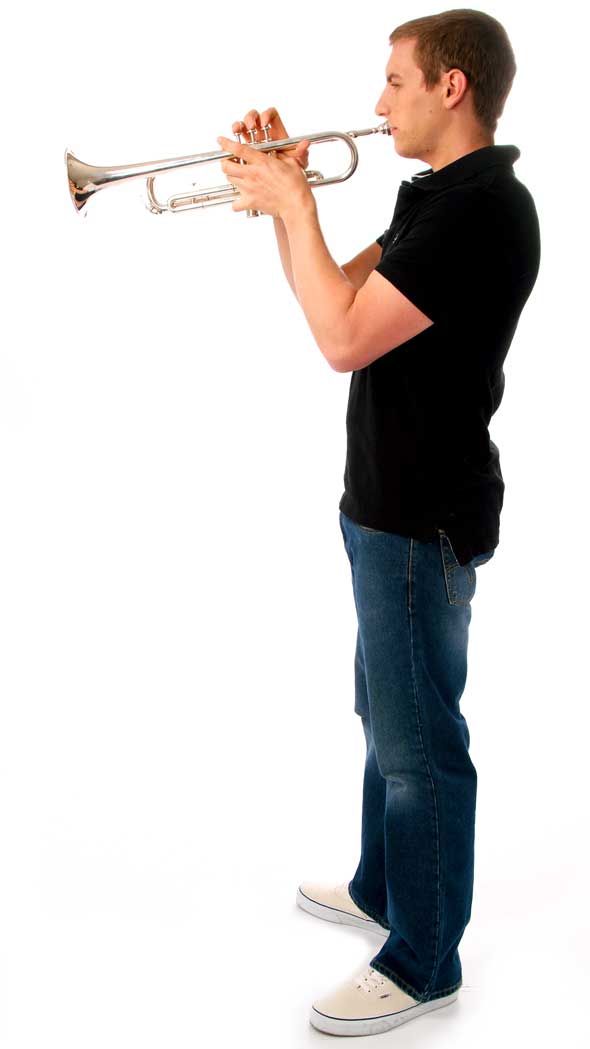
LESSON FIVE
The Common Time Signature
This symbol is called common time. It means exactly the same as *.
The following example uses the common time signature. It contains one lead-in note.
|
|
19 |
|
|
20 |
Here is an example which uses a lead-in in ^ time.
|
|
21 | The Slur |
A slur is a curved line above or below two or more different notes. It tells you to play the notes smoothly. Playing smoothly is called legato. To play legato, only tongue the first note of the group and keep blowing while you change your finger positions for the other notes.
|
|
22 |
Remember to tongue only the first note of each group of notes connected by the slur.
|
|
23 | Staccato |
A dot above or below a note tells you to play the note staccato. Staccato means to play a note short and separate from other notes. This is the opposite of legato. To play a note staccato, make a short "t" action with your tongue, and cut off your breath as soon as you tongue the note.
|
|
24 |
The following examples contain both staccato and slur marks. Staccato and slurs are examples of articulations. Articulation means the way a note is played. The way you play notes can make a big difference to the way the music sounds.
|
|
25 | Austrian Waltz |
|
|
26 |
The Tie
A tie is a curved line which connects two notes with the same position on the staff. The tie tells you to tongue the first note only, and to hold it for the length of both notes.
|
|
27 |
Play the G note and hold it for six beats.
|
|
28 |
A tie may occur either across a bar line, or within one bar. The following melody contains examples of both. Do not confuse the tie with the slur, which connects notes of different pitches.
Breathing Technique
One of the most important elements of playing any wind instrument is a consistent and relaxed approach to breathing and breath control. A good player always produces a strong, even tone and sounds relaxed regardless of the difficulty of the music being played.
Outlined below are some breathing exercises which will help you gain more control over the way you breathe when playing and give you a solid consistent approach which will eventually become automatic, enabling you to forget about breathing and concentrate totally on the music you are making.
A good way of developing your breathing technique is the use of visualization. When you breathe in, think of an inflatable life raft which fills automatically when you pull out the plug.
This will help you equate breathing in with relaxation. When you breathe out, think of a tube of toothpaste being slowly squeezed from the end (not the middle). This will help you use your breath economically in a controlled manner.
It is important to develop the habit of controlling your breathing from your diaphragm muscle (shown in the diagram below). As you breathe in, let the diaphragm relax downwards and allow the lungs to fill with air right to the bottom.
Then breathe out slowly, squeezing gently from the diaphragm (like the tube of toothpaste) and see how long you can sustain your outgoing breath. The more control you have of your diaphragm, the easier you will find breathing when you play.

Breathing Exercise
Breathing Exercise
This example makes frequent use of whole notes. Practicing long notes is an excellent way of developing your tone as well as breath control. Aim for a strong, even tone throughout the example.
Other Useful Exercises
When playing wind instruments, it is common to use more air, movement and muscle activity than necessary. There are two common exercises which are useful for learning to use less force and less air when playing.
The first of these is to slowly blow up a balloon, using slow sustained breaths controlled from the diaphragm. The idea is to take a comfortable breath using the technique described earlier and then breathe into the balloon using an even sustained amount of air pressure. Repeat this until the balloon is full.
The second exercise is to sing a melody in front of a lighted candle. This requires a more subtle release of air than blowing up a balloon, as the idea is to sing with as little effect on the flame of the candle as possible.
Once you can sustain a note without moving the flame much, try beginning the note softly and gradually increasing the volume, then reverse the process. You could also try singing a whole verse from a song. As with all aspects of musicianship, be patient and you will see great improvement as long as you continue to practice.
Posture
The term "posture" refers to the way the body is held (e.g., straight, slumped, etc) and its position when sitting or standing. For playing wind instruments, it is best to stand rather than sit, as this allows the most open and unrestricted passage of air for both breathing and sustaining notes. If you are playing in a big band, you may have to sit. In this situation, it is essential to sit up straight but relaxed, as this will produce the best sound.
If you think of a situation where a trumpet player is performing with a band, it would look fairly dull if all the players stood straight in the one position all the time. Movement is a large part of any stage show. This means it is not always possible to maintain perfect posture.
However, it is possible to keep the pathway from the diaphragm to the mouth open, flexible and relaxed most of the time, which means it is still possible to play and breathe comfortably while moving around. Relaxation and flexibility are keys to good posture regardless of standing or sitting position.
Incorrect

The spine is not straight and the head and pelvis both tilt forward. In this position, it is not possible to move freely or produce the best sound.
Correct

The spine is comfortably straight and in line with the head, legs and pelvis. This position keeps the airways open and makes movement easy and comfortable.